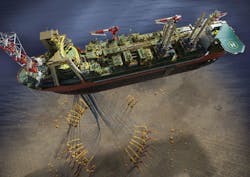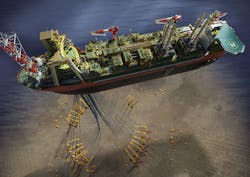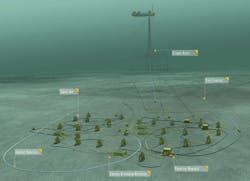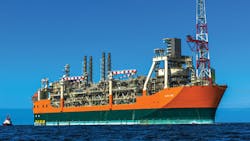BP advances brownfield technology with Quad 204 start-up
Subsea system deemed to be one of the largest in the world
Sarah Parker Musarra
Special Correspondent
BP brought its Quad 204 project into production this past May, completing a large-scale redevelopment of the Schiehallion Area. Comprising the field of the same name and its neighbor adjacent, Loyal field, the pair have pumped around 400 MMbbl of oil since being originally brought into production in 1998. The operator and its partners, Shell and Siccar Point Energy, expect to produce an additional 450 MMbbl of resources from the brownfield redevelopment, extending the life of the fields into 2035 and beyond.
“We are moving from something like 18% recoverable reserves to 40%,” BP’s Andrew Train, Quad 204’s Subsea Project General Manager told Offshore, noting that accessing such a volume of additional resources in place is like “finding a new oil field.”
Sanctioning the project in 2011, production was suspended for around four years to allow for the existing Schiehallion FPSO to be removed, comprehensive upgrade and modernization of the subsea infrastructure and installation of the new Glen Lyon FPSO. BP has said that the redevelopment of the Schiehallion Area is one of the most complex and challenging projects it has ever undertaken.
Life of field
Located 175 km (109 mi) west of the Shetland Isles in about 396 m (1,300 ft) of water, Schiehallion and Loyal were discovered in 1993 and 1994, respectively. Following Foinaven as BP’s second development west of Shetland, Schiehallion was sanctioned in 1996 and began producing oil in 1998 through the original Schiehallion FPSO. Over time, it would be progressively expanded to 51 subsea wells located over five drill centers before production would eventually be suspended in 2013 for the redevelopment. Train said that one of the early concepts considered was to produce both Foinaven and the Schiehallion Area through one floating production system, which is how the project gained the name Quad 204, as both are located in the UK continental shelf quadrant 204. This idea was scuttled in the early phases, and the Schiehallion Area received its own FPSO.
The cyclical nature of the oil and gas business is illustrated in the Schiehallion Area’s development and then redevelopment into the Quad 204 project. The fields were discovered and originally sanctioned during a previous period of low oil prices, and amidst the UK’s Cost Reduction in the New Era (CRINE) initiative. As Train explained it, some elements of the CRINE period might sound familiar to those riding out the industry’s latest downturn.
“At that point in time, there was a low oil price; the North Sea was trying to become more competitive both commercially and internationally. Alliancing was the order of the day, along with trying to make things a lot more cost-efficient. The result was that the Schiehallion FPSO was fast-tracked. Some of the technology used was maybe chosen on a cost basis, rather than a long-term integrity basis,” he said.
To this last point, however, he noted that Schiehallion was originally sanctioned to recover around 250 MMbbl and the asset had “over achieved” by recovering nearly 400 MMbbl of oil equivalent through the FPSO since the field came onstream.
“[The Schiehallion FPSO] had done the job that it was originally intended to do, but had become a challenging asset to manage,” Train continued. “The operating efficiency … was going down to something like 40%. It had recovered more than it was originally intended,” Train said. “But for another 15 years of life … it just wasn’t suitable for that.”
As technology advanced and made accessible additional resources, BP found it had plenty of oil left for extraction and began considering its options to extend the life of this brownfield development. Initially, Train said that plans considered included different levels of refurbishment for the Schiehallion FPSO, from selective upgrade of the topsides facilities to a full replacement, or moving to a semisubmersible or tension leg platform. In the end, the company considered multiple options before electing to construct a new FPSO, which would be positioned at the same location as the original.
Looking to increase the brownfield’s life by many years, BP decided to substantially update, replace, and increase the capacity of the field’s already vast subsea infrastructure. In full, Quad 204’s work scope included a large-scale modernization and redevelopment of the subsea infrastructure and a plan to drill up to 20 new wells. The new Glen Lyon FPSO would be connected to a combination of legacy and new subsea infrastructure to restart production.
In a statement, Group Chief Executive Bob Dudley said that Quad 204 was “one of the largest recent investments in the UK,” with the company claiming to have delivered more than £2 billion ($2.5 billion) of investment to UK companies.
Redevelopment scope
Production was stopped in the Schiehallion Area in early 2013 to allow for work on the Quad 204 project to begin. Many systems needed to be removed or replaced to different degrees, as well as expanded.
Train described the redevelopment’s subsea system as “one of the largest, if not the largest in the world.” The company worked with Wood Group Kenny on the subsea design engineering, various legacy equipment suppliers and Technip for installation and flexible pipe supply. Schiehallion Area has five drill centers, Central, West, North, North West, and then, separately, Loyal’s drill center. It currently has 52 wells, and another 20 new wells are envisaged as part of the Quad 204 redevelopment, bringing the field’s potential total up to more than 70 subsea wells. Of the planned 20 new wells, part of a £1.3-billion (more than $1.6-billion) drilling campaign, Train said that eight have been drilled at press time.
Quad 204’s subsea infrastructure comprises of production, water and gas systems and an integrated subsea control system. The production system has virtually all been replaced except for several existing manifolds, jumpers and xmas trees on the existing wells. Production capacity has been expanded by 50% with 15 new production flowlines replacing the original 10. The water injection system mainly comprises the existing equipment along with some expansion; namely, two additional manifolds and various jumpers to allow the tie-in of the planned new wells. The gas lift system was primarily left intact and upgraded to run at higher flow rates to serve the additional wells while the control system was completely replaced to improve reliability and provide increased diagnostics.
For the new, substantially larger FPSO to connect to the subsea infrastructure, all the gas, water, and production risers were replaced, along with two dynamic umbilicals, and the mooring system completely replaced. The company claims that the risers have the largest bend stiffeners in the world designed to protect the risers as they interface with the FPSO turret and accommodated vessel movement in the harsh west of Shetland environment.
Glen Lyon FPSO
Constructed at the Hyundai Heavy Industries shipyard in Ulsan, South Korea, the Glen Lyon FPSO took four years to build. Anchored by a weathervaning turret mooring system that features 20 mooring lines almost 1 mi (1.5 km) in length, replacing the 14-line mooring system of the previous asset.
The Schiehallion FPSO was 230 m (755 ft) long and 38 m (15 ft) across the beam, while the new Glen Lyon asset is longer and wider at 270 m (886 ft) and 52 m (170 ft) respectively. The main reason behind the increased size is to accommodate the topsides process and utilities systems required to process much larger volumes of fluids that will be received on the new FPSO.
Train said that so-called dry oil, hydrocarbons without any associated water, had already been extracted, so Quad 204 would be producing wet oil with around 50-60% water cut. That water would then have to be separated from the oil, so the production facility on Glen Lyon is designed especially with this consideration. The higher water cut called for larger and additional separators, as well as more power, which all adds up to more space and a larger FPSO.
Train said that a unique feature of Quad 204, as a brownfield development, is that production, water injection and gas systems need to be brought online simultaneously or within a short period of start-up. The reservoir is relatively low pressure and the high water cut requires most wells to be gas lifted to produce. A greenfield development is likely to produce for a significant period before water and gas systems are necessary. This factor alone had a major bearing on sequencing and integration of design, equipment manufacture, installation and the start-up sequence.
In replacing the Schiehallion FPSO, Train said that the largest challenge presented was the necessity to complete “a lot of destruct before we could do any construct.”
The existing 18 risers were disconnected and laid back on themselves before the 14 moorings were disconnected and the FPSO removed from the field. Once the FPSO was off station the risers and equipment that remained had to be recovered and returned onshore with over 95% of materials recycled in an environmentally sensitive manner. At the drill centers, obsolete flowline jumpers and control leads were removed to facilitate reconfigurations and expansion of the infrastructure through addition of manifolds for new well slots.
BP project managed the topsides hook-up of the FPSO with Amec-Foster Wheeler as the main construction contractor and the BP commissioning team was supported by QEDI.
Production from the project is expected to ramp up to a plateau level of 130,000 b/d before the end of 2017.
Overcoming subsea challenges
Subsea technology has taken off over the last few decades, and many of these enhancements and improvements would be critical to Schiehallion’s revamped subsea system, especially since Train said it was one of the first deepwater developments when it came onstream in the late-1990s.
Train said brownfield redevelopments such as Quad 204 required “a fine balance between understanding what you need to replace and what you are able to keep.” That balance was particularly challenging here, given the complexity of the existing subsea system and the need to expand capacity and extend field life. An additional challenge would be compatibility issues, particularly pairing up the new control system with legacy equipment.
“Subsea technology has evolved and improved, and through field life there had been enhancements and updates to the control system within Schiehallion. So, what we had to do was design a system that could accommodate different evolutions of the existing control modules and at the same time take a step into the future with the latest controls technology,” Train said. A standard was established for the control system that considered the types of technological evolutions and industry learnings since the field was first designed. From there, BP worked with Aker Solutions, the control system provider, to ensure it was backwards and forwards compatible.
For example, to manage the compatibility between new and legacy, BP used controls distribution assemblies. With high-speed communications coming from the FPSO, that distribution assembly on the seabed would then slows down the signal speed, then take the signal to each of the individual wells. There are 14 distribution assemblies on the seabed at different drill centers. It was designed to provide the highest possible reliability and enhanced diagnostics capability back to Glen Lyon, and BP said it would also avoid the need for an intervention vessel that would otherwise perform the diagnostics.
Train likened it to “moving from analog to digital.”
A decision was also made to switch to an integrated control system between subsea and topsides, a change from the previous system, which Train described as being much like a separate unit bolted on to the topsides control system.
Another key challenge he identified was in the diver-less flowline connection system. BP standards for subsea materials had moved on from the original field design and requalification of the connection system, supplied by AFGlobal, using different materials was necessary. The original ROV tooling used for the DMaC connection system had been in service across the Foinaven and Schiehallion assets for the original developments and through operations. Two new suites of tooling systems were designed and built to make and break over 200 connections that would be needed as part of the redevelopment. These were integrated with work-class ROVs.
Aker Solutions and AFGlobal were not the only legacy equipment manufacturers to return to work on the Quad 204 project. Others included OneSubsea, who had provided the new and replacement subsea Xmas trees.
Train said another key challenge in redevelopment was the highly congested seafloor. Once again, a lot of destruct was necessary before proceeding with the new build-out. The company said that 96 items were disconnected and recovered from the seabed before installing more than 292 new assembled components over five drill centers and the FPSO location. Due to the water depths, everything was completed diverless, adding an additional challenge, with ROVs moving around the congestion and working on both new and the more challenging legacy equipment. Subsea construction took over 3,000 construction vessel days using 14 different construction support and pipelay vessels over a five-year period. The harsh water west of Shetland environment required all work to be compressed into five- to six-month “summer” window. At peak, there were 11 vessels and over 900 people working infield at the same time.
Train said that a key success factor for the subsea construction work was a highly collaborative relationship with the installation contactor Technip. The combined team recognized the challenges of successive and complex offshore campaigns and focused on planning each campaign “in excruciating detail,” closely tracking safety and efficiency performance during the operations and having pre-determined contingencies readily available when unexpected events occurred or to bring activity back in line with the plan. Through learning and continuous improvement, he explained that the team was able to increase vessel working efficiency by over 20% from the first campaign, achieve each campaign full scope and even pull some work forward.
In addition to layering in various technological enhancements that have occurred over the years, BP’s own standards and practices have progressed over the years. This meant materials had to be verified against latest standards and practices. As a prime example of this, Train said that in the analysis of the existing gas lift and export infrastructure, BP found an issue with a phenomenon known as flowline-induced pulsation. This required laboratory testing to design and build dampers that were then installed by ROV at more than 30 locations on pipework within existing manifolds on the seabed. Train said it was a full project within its own right, with detailed analysis on everything from the design of the damper to where the dampers would be placed through to installation and testing.
Drilling campaign
In 2015, BP started a seven-year drilling campaign west of Shetland as part of the redevelopment, with the sixth-generationDeepsea AberdeenMODU contracted from Odfjell Drilling. The work began on Loyal and then moved to Schiehallion as part of the campaign.
Once again, newer technology and advanced understanding met up with legacy equipment, Train said, which led to some unexpected re-design work.
The rig had a bigger, stiffer drilling riser system than the fourth-generation rig that had been in use until that point. This resulted in greater forces being exerted on the wellhead system, he said, causing the team to have to move from a 36-in. conductor to a 42-in. conductor. That in turn meant a new verification program around the welding and fabrication of the larger conductor that would take time. On the first six wells, BP had to design, fabricate, and install a support structure that would allow the use of the 36-in. conductors until the verification program on the 42-in. conductor was complete.
Train said that “the investment in the wellhead system and the new MODU has paid dividends as the wells are being drilled and completed safely, much more efficiently and at significantly reduced cost than before.”
Quad 204 by the numbers
- Location: 175 km west of Shetland in about 1,300 ft of water
- First oil:Schiehallion/ Loyal in 1998; Quad 204 in May 2017
- Life-of-field:2035 and beyond
- Estimated resources:450 MMboe
- Subsea:Seven new manifolds, the capacity has extended to beyond 75 wells. Of the 21 risers, 15 are for producers, three are for gas risers, and three are for water injection.
- Production:Claimed to be the world’s largest harsh environment FPSO, Glen Lyon measures 270 m long by 52 m wide and weighs around 100,000 metric tons. Deepsea Aberdeen will be used to drill the planned additional 20 wells in addition to the original 29 wells. Glen Lyon can process and export up to 130,000 b/d and store up to 800,000 bbl of oil. It is anchored by weathervaning turret mooring system and features 20 mooring lines each of which are 1.6 km long.
Source: BP



